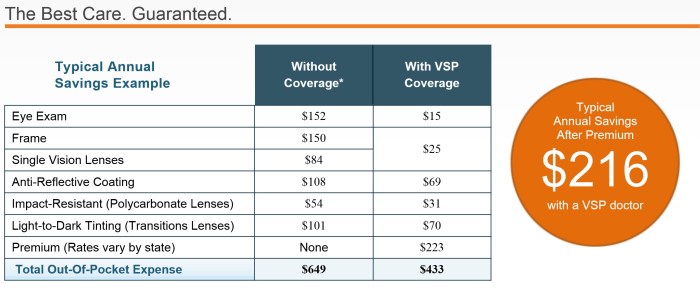Vision insurance plans are like a safety net for your eyes, providing financial assistance for routine eye care and corrective lenses. Unlike health insurance, which focuses on overall health, vision insurance specifically covers the costs associated with maintaining healthy vision.
This can include everything from annual eye exams and contact lens fittings to the purchase of eyeglasses and even specialized vision services like laser eye surgery (depending on the plan).
Navigating the world of vision insurance can be a bit like choosing the right pair of glasses – there are many options, and finding the perfect fit for your needs can feel overwhelming. But fear not! We’ll break down the different types of plans, key features, and factors to consider when choosing the right vision insurance for you.
Understanding Vision Insurance: Vision Insurance Plans
Vision insurance is a type of insurance that helps cover the costs of eye care, such as eye exams, eyeglasses, and contact lenses. It’s designed to make these essential services more affordable and accessible.
Differences between Vision and Health Insurance
Vision insurance is distinct from health insurance, though both play important roles in your overall well-being. Health insurance primarily focuses on medical expenses related to illnesses, injuries, and hospitalizations. In contrast, vision insurance specifically targets eye care needs.
Common Benefits Covered by Vision Insurance Plans
Vision insurance plans typically offer a range of benefits to help you manage your eye health and vision needs. These benefits often include:
- Eye Exams:Regular eye exams are crucial for detecting early signs of eye diseases and vision problems. Most vision insurance plans cover the cost of routine eye exams, typically at a set frequency, such as annually.
- Eyeglasses:If you require eyeglasses, vision insurance plans often provide coverage for the cost of frames and lenses. The coverage may include a specific allowance or a co-pay, with the insured paying the remaining balance.
- Contact Lenses:Similar to eyeglasses, vision insurance may cover the cost of contact lenses, including soft lenses, hard lenses, and disposable lenses. Coverage may have limitations on the type and quantity of lenses covered.
- Vision Correction Surgery:Some vision insurance plans may offer partial coverage for vision correction surgeries, such as LASIK, PRK, and ICL. However, coverage for these procedures is often limited and may have specific requirements.
Types of Vision Insurance Plans
Vision insurance plans offer a variety of coverage options, each with its own set of benefits and limitations. Understanding the different types of plans available can help you choose the one that best suits your individual needs and budget.
HMO Vision Plans
HMO vision plans are typically the most affordable option. They operate on a network-based system, meaning you’ll need to see providers within their network to receive coverage. HMO plans often have lower out-of-pocket costs, but they may have limited provider choices and require referrals from your primary care physician.
Features and Limitations
- Lower Premiums:HMO plans generally have the lowest monthly premiums compared to other types of vision insurance.
- Limited Provider Network:You must see providers within the HMO’s network for coverage. This may limit your choice of eye doctors and specialists.
- Lower Out-of-Pocket Costs:HMO plans often have lower copayments and deductibles, making them a good option for those who expect frequent eye care needs.
- Referral Requirements:You may need a referral from your primary care physician before seeing an eye doctor.
Real-World Scenarios
An HMO vision plan would be a suitable choice for someone who:
- Prioritizes affordability and has a limited budget.
- Doesn’t mind using a specific network of providers.
- Expects to need frequent eye care services.
PPO Vision Plans
PPO vision plans offer more flexibility than HMO plans. They allow you to see providers both within and outside their network, although coverage may be higher for out-of-network services. PPO plans generally have higher premiums than HMO plans but offer more provider choices and greater flexibility.
Features and Limitations
- Larger Provider Network:PPO plans have a wider network of providers, giving you more choices for eye care.
- Higher Premiums:PPO plans typically have higher monthly premiums than HMO plans.
- Out-of-Network Coverage:You can see providers outside the PPO network, but you’ll likely pay higher out-of-pocket costs.
- No Referral Requirements:PPO plans usually don’t require referrals for eye care services.
Real-World Scenarios
A PPO vision plan would be a suitable choice for someone who:
- Prefers more provider flexibility and choices.
- Is willing to pay higher premiums for greater freedom.
- May need to see a specialist or provider outside the network occasionally.
Fee-for-Service Vision Plans
Fee-for-service vision plans offer the most flexibility but are also the most expensive. These plans allow you to see any eye care provider you choose, and you’ll pay a portion of the cost, typically a percentage of the total bill.
Features and Limitations
- Unlimited Provider Choice:Fee-for-service plans give you the freedom to choose any eye care provider you wish.
- No Network Restrictions:You can see any provider, regardless of whether they are in a network.
- Highest Out-of-Pocket Costs:Fee-for-service plans typically have the highest out-of-pocket costs.
- No Coverage Limits:Fee-for-service plans often have higher coverage limits than other types of vision insurance.
Real-World Scenarios
A fee-for-service vision plan would be a suitable choice for someone who:
- Values complete freedom to choose their own eye care provider.
- Is willing to pay the highest out-of-pocket costs for maximum flexibility.
- Needs specialized eye care services that may not be covered by other plans.
Key Features of Vision Insurance Plans
Vision insurance plans offer a range of benefits designed to help you manage your eye health and vision care needs. These plans typically cover a variety of services, including eye exams, contact lens fittings, and eyeglasses. Understanding the key features of vision insurance can help you choose a plan that best suits your individual requirements and budget.
Coverage Limits
Vision insurance plans typically have coverage limits that determine the maximum amount they will pay for specific services. Here’s a breakdown of common coverage limits:
- Annual Eye Exams:Most plans cover one comprehensive eye exam per year, which includes a check-up of your overall eye health and vision. Some plans may offer additional coverage for specific types of exams, such as glaucoma screening or diabetic eye exams.
- Contact Lens Fittings:Coverage for contact lens fittings may vary depending on the plan. Some plans cover one fitting per year, while others may offer more frequent fittings. The plan may also have limitations on the types of contact lenses covered, such as soft lenses versus hard lenses.
- Eyeglasses:Eyeglass coverage typically includes a specific allowance for frames and lenses. This allowance can vary depending on the plan, with some plans offering a higher allowance than others. The plan may also have restrictions on the types of frames and lenses that are covered.
Copayments, Deductibles, and Out-of-Pocket Expenses, Vision insurance plans
Vision insurance plans typically involve copayments, deductibles, and out-of-pocket expenses. Understanding these terms is crucial to calculate the total cost of your vision care:
- Copayments:A copayment is a fixed amount you pay for each covered service, such as an eye exam or contact lens fitting. Copayments are typically lower than the full cost of the service and are paid at the time of service.
Vision insurance plans are a great way to keep your peepers in tip-top shape, but what about those wanderlust-filled adventures? Before you jet off to explore the world, make sure you’re covered with a solid travel insurance plan. You can get personalized quotes and compare plans here to ensure you’re protected from unexpected hiccups.
Then, with peace of mind, you can focus on those stunning views, knowing your eyes are insured and your travels are covered!
- Deductible:A deductible is the amount you pay out-of-pocket before your insurance starts to cover the cost of your vision care. Once you have met your deductible, your insurance will begin to pay for a portion of your covered services. Deductibles can vary widely depending on the plan.
- Out-of-Pocket Expenses:Out-of-pocket expenses refer to any costs you pay for vision care that are not covered by your insurance. This may include services that are not covered by your plan, exceeding the coverage limits, or paying for services before you meet your deductible.
Selecting a Vision Insurance Plan
Choosing a vision insurance plan requires careful consideration of your individual needs and budget. Here are some factors to consider when selecting a plan:
- Coverage Limits:Consider the coverage limits for services you anticipate needing, such as eye exams, contact lens fittings, and eyeglasses. Make sure the plan covers the types of services you require and the frequency with which you need them.
- Copayments and Deductibles:Compare the copayments and deductibles of different plans to determine which plan offers the most affordable coverage. Consider how often you expect to use your vision insurance and the potential cost of services.
- Network of Providers:Ensure that the plan includes a network of providers that meet your needs. Check if your preferred eye doctor is in the plan’s network. You may have to pay more for services outside of the network.
- Budget:Consider your overall budget and choose a plan that fits your financial situation. Compare the premiums, copayments, deductibles, and out-of-pocket expenses of different plans to find the most cost-effective option.
Finding the Right Vision Insurance Plan

Navigating the world of vision insurance can feel like deciphering a complex code. But fear not! This guide will equip you with the knowledge to find the perfect plan for your needs. Understanding your options and comparing plans is key to making an informed decision.
Key Factors to Consider
When choosing a vision insurance plan, several key factors come into play. These factors determine the value and suitability of a plan for your specific requirements.
- Provider Network:This refers to the network of eye care professionals (doctors, optometrists, and opticians) that your plan covers. It’s essential to ensure that your preferred eye doctor is part of the network. Otherwise, you might face higher out-of-pocket costs.
- Coverage Limits:This determines the maximum amount your plan will cover for specific services like eye exams, glasses, or contact lenses. Higher coverage limits usually mean lower out-of-pocket expenses.
- Premiums:This is the monthly or annual cost of your vision insurance. Premiums vary based on the plan’s coverage and the insurer. You’ll need to balance your budget with the level of coverage you require.
- Deductible:This is the amount you pay out-of-pocket before your insurance coverage kicks in. A higher deductible typically translates to lower premiums, while a lower deductible means higher premiums.
- Co-pays:This is a fixed amount you pay for specific services, like eye exams or contact lens fittings, even after meeting your deductible.
Comparing Vision Insurance Providers
Understanding the pros and cons of different vision insurance providers is crucial for making an informed decision. This table compares some popular providers based on their coverage, network size, and customer service.
| Provider | Pros | Cons |
|---|---|---|
| Provider A | Extensive provider network, generous coverage limits, excellent customer service. | Higher premiums compared to some competitors. |
| Provider B | Competitive premiums, good coverage for basic services. | Limited provider network in certain areas, average customer service. |
| Provider C | Wide range of plan options, strong online resources. | Smaller provider network, limited coverage for specialized services. |
Using Vision Insurance Benefits

Vision insurance is a valuable asset, but it’s only beneficial if you know how to use it. Navigating the process of filing claims and understanding your coverage is key to maximizing your benefits.
Understanding Your Coverage
It’s essential to read your policy carefully and understand the details of your coverage. This includes knowing what services are covered, the maximum benefits, and any limitations or exclusions. Understanding your policy helps you make informed decisions about your vision care.
Filing Claims
Most vision insurance plans require you to file a claim to receive reimbursement for covered services. Here’s a general process:
- Obtain a Claim Form:You can usually find claim forms online or by contacting your insurance provider.
- Complete the Form:Fill out the form accurately and completely, including your policy number, the date of service, the provider’s information, and the services received.
- Submit the Claim:You can submit your claim online, by mail, or by fax, depending on your provider’s instructions.
- Receive Reimbursement:Once your claim is processed, you will receive reimbursement for covered services, typically within a few weeks.
Maximizing Your Benefits
Here are some tips to help you get the most out of your vision insurance:
- Choose an In-Network Provider:In-network providers have negotiated rates with your insurance company, which can lead to lower out-of-pocket costs.
- Schedule Regular Eye Exams:Most vision insurance plans cover annual eye exams, which are crucial for maintaining good eye health.
- Utilize Your Coverage for Eyeglasses and Contact Lenses:Many plans offer coverage for eyeglasses and contact lenses. Make sure to take advantage of these benefits to save on costs.
- Understand Your Deductible and Co-pay:Be aware of your deductible and co-pay amounts so you can budget accordingly.
- Ask Questions:Don’t hesitate to ask your insurance provider or your eye doctor any questions you have about your coverage or benefits.
Last Word

In the end, understanding vision insurance is about taking control of your eye health. By choosing the right plan and maximizing your benefits, you can ensure that you have access to quality vision care without breaking the bank. So, whether you’re a young professional, a busy parent, or a retiree, take the time to explore your vision insurance options and see clearly into the future.
FAQ Section
What are some common vision insurance exclusions?
Vision insurance typically excludes cosmetic procedures, such as LASIK surgery, unless specifically included in your plan. Additionally, they may not cover pre-existing conditions, experimental treatments, or services deemed medically unnecessary.
Can I use my vision insurance for any eye doctor?
Most vision insurance plans have a network of participating providers. You’ll typically pay less if you see an in-network provider. However, some plans offer out-of-network coverage, but you might face higher costs.
How often can I get new glasses or contacts under vision insurance?
The frequency of coverage for new glasses or contacts varies depending on the plan. Some plans allow for a new pair every year, while others might have longer intervals. Check your plan’s details for specific coverage limits.
How do I know if I need vision insurance?
If you regularly wear glasses or contact lenses, have a history of eye problems, or are concerned about your vision health, vision insurance can provide valuable financial protection. It’s also a good idea to consider it if you’re part of a family with children, as they often require more frequent eye care.